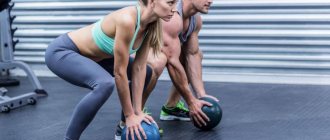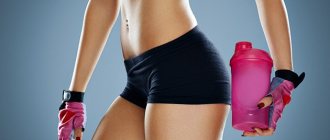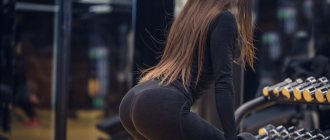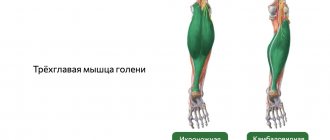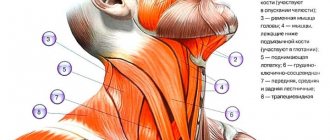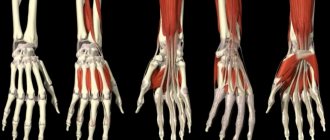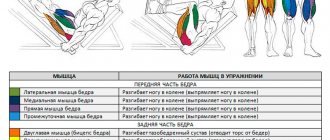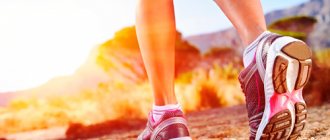How often have you seen people in the gym doing exercises aimed at working their neck muscles? You probably won’t find such people among beginners. In general, beginners often come to the gym to pump up one specific part of the body, and do not think at all that the key to forming a beautiful, aesthetic figure is its harmony. Unevenly pumped muscles look comical.
One area that many people don't pay enough attention to when training at the gym is the neck. The functions performed by the neck muscles are diverse: they allow us to chew food, swallow it, they hold the head, allow us to rotate it, raise it up and down.
Why do you need to shake your neck?
Perhaps everyone has different reasons for this.
Women pump their neck muscles to give their neck and décolleté an elegant shape that will highlight their feminine beauty. Such training helps the skin gain greater elasticity, prevent the formation of a double chin, and preserve youth longer. They, of course, perform exercises with lighter weights than men.
Men work on pumping up their neck muscles both for aesthetic reasons (agree, a fragile thin neck will look strange against the backdrop of a well-developed muscular body) and for practicality reasons. Strong neck muscles are necessary for athletes involved in various types of martial arts. They prevent injury from impacts. For bodybuilders, strong neck muscles allow them to efficiently perform basic exercises with heavy weights.
It must be remembered that the neck is an extremely delicate part of the body and should never be overloaded. When performing exercises to pump up the neck muscles, always remember that the cervical vertebrae can be extremely vulnerable, especially at the very beginning of training.
In addition, for some people it is really contraindicated to train the neck muscles, so before starting training, be sure to consult a doctor (you need to do an ultrasound of the cervical spine), and start training the neck muscles only if the doctor allows it.
Preventing neck and shoulder pain
Pain in the neck can be different - pulling, throbbing, shooting, tingling. To minimize the occurrence of such symptoms, you should adhere to the following recommendations:
- As mentioned, raising your laptop, book, tablet or cell phone to eye level can relieve pressure on your spine. Buy a reading stand or adjustable table. If you use a computer at an office or desk, adjust your chair and monitor to suit your height.
- Set a timer to remind you to get up, walk around, and straighten your back at least once every hour.
- Stretch regularly. Stretching exercises help improve posture and reduce musculoskeletal pain.
- Don't sleep on a high pillow. Firstly, it is impossible to maintain an anatomically correct position with it, and secondly, because of it, the vertebral arteries that feed the brain and allow it to function normally can be compressed.
- When talking on the phone, do not hold your smartphone between your head and shoulder. If you use this method frequently, switch to a headset or speakerphone.
- Avoid carrying bags and backpacks on one shoulder, be sure to change their order, and also remember that the weight of the bag should not exceed 10% of your body weight. If it is heavier, and especially if you wear it constantly on the same side, it can cause curvature of the spine, and, as a result, pain.
- Get a massage. It helps relieve muscle spasms, improves blood circulation, and also increases range of motion by removing accumulated lactic acid.
Don’t bypass sets of exercises for the neck and whole body. It is very important to maintain a toned core, which consists of the muscles of the abdomen, back and buttocks. If they are in good shape, then this allows you to stabilize the spine, preventing it from sagging and deforming. And healthy posture plays a key role in neck health.
It is also important to take measures to prevent osteoporosis. Loss of bone mass in the spine can lead to injury, slouching, and increased pain.
Warm-up before neck muscle training
Whatever muscle group we work on, we first need to do a warm-up, and the neck muscles are no exception. Warm-up is necessary in order to warm up the muscles, disperse the blood, and avoid injuries, muscle spasms and overexertion.
Warm-up for the neck muscles is familiar to all of us from school physical education lessons. These are standard head turns left and right, head tilts up and down, circular rotations of the head in different directions, and so on.
When doing the warm-up, try to keep all your movements smooth and calm, do not rush, do not chase the speed of the exercise, otherwise you will only harm yourself. Do not perform more than five repetitions of each exercise on one side, as this can also lead to negative consequences.
Warm-up
Before loading your neck, you need to warm up your neck muscles and joints.
- To do this, stand up straight with your feet shoulder-width apart. Leave your hands on your belt. Some people may feel dizzy during exercise. Therefore, be careful.
- Tilt your head all the way to the right, then to the left. Slowly.
- Rotate your head clockwise and back. Again, do everything slowly. When you rotate your head, try to draw a circle with the maximum radius.
- Another great exercise is to draw a huge figure eight with your nose in the air. The movement is difficult, so it warms up the neck perfectly.
Spend at least 2-3 minutes warming up. And never start working with cold muscles.
The best exercises for pumping up your neck
All strength exercises aimed at pumping up the neck muscles are based on the principle of overcoming resistance. This resistance can be created by the machine, your own hands, or the hands of your partner.
Pumping the posterior cervical muscles
Starting position: lying on your back, on a horizontal bench. Let your neck hang over the edge of the bench.
There are two options for performing this exercise. One of them involves individual training, that is, you create the resistance yourself, the other uses the help of a partner. Personally, in my opinion, it is more convenient to perform this exercise alone, because it is easier to monitor progress and gradually increase the load. In the case of a partner, it is extremely problematic to track such indicators. However, many athletes, on the contrary, prefer to perform this exercise in pairs.
Option one - do it yourself:
Take a small pancake in your hands and take the starting position. The pancake in this case will be the resistance that you will overcome. Place the pancake on your forehead, holding it with your hands so that it does not fall. Then slowly begin to lower and raise your head. On inhalation, the head lowers, on exhalation, it rises.
The head moves in a straight line. During the exercise, no sudden movements are made, everything happens smoothly and without haste. You need to perform three sets of 5-20 repetitions. Start with a small number of repetitions and gradually increase their number. When you can comfortably perform 20 repetitions in each of the three approaches, you can slightly increase the weight. As you increase the weight, start again with low reps.
Option two – performing with a partner:
Take your starting position. Ask your partner to place their hands on your forehead. The partner is here instead of a pancake, that is, he acts as resistance. Exactly the same as in the first option, slowly lower your head down as you inhale, and lift it up as you exhale. When you raise your head up, your partner, pressing his hands on your forehead, seems to be trying to lower your head down. In this case, a kind of confrontation occurs.
Similarly, you can pump up the lateral muscles of the neck, both independently and with a partner. The only difference is that to pump up the side muscles you will need to sit sideways on the bench. Remember to work both sides evenly, performing the same number of reps and sets on each side.
sternocleidomastoid muscles
Starting position: lying on a horizontal bench on your stomach, so that your head hangs from the bench.
The exercise can be performed either independently or with a partner. In the first case, there is a plate on the back of the head, which you independently hold with your hands, lowering and raising your head. In the second case, instead of a pancake, your partner’s hands are located on the back of your head.
In addition, I have personally observed this exercise being performed in the gym using a hamstring machine. The athlete, lying on a bench, placed his neck under a bolster and performed the exercise, lowering and raising his head.
Who needs to pump up their neck muscles?
To reduce the risk of pain and injury, everyone can benefit from training these muscles. Most of us today have sedentary work at a computer, in which case pumping the neck muscles helps prevent cervical osteochondrosis. A strong neck reduces the pressure you can put on it and prevents soreness if you are in an awkward position for a long time.
In addition, during a stressful situation, the muscles of the trapezius and neck are under tension, and strong muscles reduce it. To reduce stress, stretch more.
Athletes of all sports (and especially martial arts) believe that pumped up neck muscles are extremely useful. Not only do they protect against collisions in contact sports, but they can also prevent concussions from impacts. In MMA, Brazilian Jiu-Jitsu and other combat sports, locks and neck holds are common, so developing a powerful neck is important not only for beauty, but also to prevent associated injuries. Wrestling bridges on the ground, when you need to hold not only your own weight on your neck, but also the weight of your opponent, are unthinkable without strong muscles.
In bodybuilding, a strong neck provides stability during heavy-weight compound exercises, such as squats and overhead pull-downs. And in everyday life, it is important for us to be able to look at our feet, up, to the side, and even just look back! And finally, you must agree that pumped-up neck muscles attract attention, because a strong neck is a sign of a tough guy!
Anatomical features of the neck muscles
The basis of the neck is made up of seven interconnected vertebrae; our mobility is ensured by their special structure and the presence of muscles. All neck muscles are divided into three groups: superficial, middle and deep.
The median muscles are responsible for the functioning of the jaw and larynx. The deep muscles of the neck are divided into lateral and prevertebral groups, which perform the function of tilting forward and to the side. You use them, for example, during the warm-up before training to pump up, say, your shoulders, when you tilt your head back and forth and left and right.
The lateral muscles provide elongation of the neck and shape its width, forming a muscle bundle directly above the collarbone. Bodybuilders strive to work this particular neck muscle because it provides full development of the back and a beautiful, symmetrical appearance from the front. And working out all the neck muscles helps develop more visible trapezius muscles and provides additional support for the spine.
Unfortunately, many training programs do not include neck exercises. Ideally, to achieve the best results, you need to dedicate a separate workout to the neck muscles, or do them after targeted work on the abs or forearms on days when you are not training the main parts of the body.
Other exercises
It should not be forgotten that many compound exercises also involve the neck muscles (for example, deadlifts, shrugs, etc.). In addition, there are wrestling methods for pumping up the neck, such as the back wrestling bridge. This is undoubtedly an excellent exercise for increasing muscle endurance, but it should never be performed by a beginner without the supervision of an experienced trainer, as performing the exercise incorrectly can result in serious injury. In addition, it is unlikely to lead to significant muscle growth.
In addition, you can perform exercises not with a plate, but with a special strap for traction . A weight is attached to one side of this strap, and the other is fixed on the athlete’s head.
Remember that all exercises to develop the neck muscles should be performed with a small amplitude.
Training
Lying weighted head raises
- 3 sets of 8-12 reps
- Body Part: Neck Equipment: Other
Weighted head raises while lying on your back
- 3 sets of 8-12 reps
- Body Part: Neck Equipment: Other
Shrugs with a barbell
- 3 sets of 8-12 reps
- Body part: Trapeze Equipment: Barbell
Standing dumbbell shrugs
- 3 sets of 6-10 reps
- Body part: Trapeze Equipment: Dumbbells
Raising dumbbells in front of you
- 3 sets of 6-10 reps
- Body part: Shoulders Equipment: Dumbbells
Seated lateral raises with dumbbells
- 3 sets of 8-12 reps
- Body part: Shoulders Equipment: Dumbbells
Add to Calendar * Add to My Workouts * Print Workout
* — The service is in beta testing
But in order to achieve the desired result and build a powerful neck, you should not limit yourself solely to training. Think about what you eat. Your diet must be correct and healthy so that your body receives enough nutrients and building material for muscle growth. If you are engaged in intense training and are actively building muscle mass, then sports supplements will help you quickly replenish the nutrients your body needs.
Neck extensions
Neck extensions work the back of the neck.
They are needed for maximum volume and to make your neck look powerful from the back.
Rewind to 5:39 and you'll see neck extensions.
Is it possible to shorten the training program?
If you don't have enough time or are very lazy, then you can do just one exercise.
This is neck flexion.
Neck curls will give you optimal development of the anterior and lateral neck muscles.
For a purely visual effect, only this exercise will be enough.
But if you want maximum development of the neck, which will save you in a difficult situation and will be the most bullish neck, then be so kind as to train the side and back of the neck.
I tried to make the instructions as complete as possible so that you don’t need any other resource to pump up your bull neck. Open it and everything you need is here.
If I missed something, please comment and I will add to the instructions.
Start training today and get a thick neck in just a few months.
I wish you to achieve results and look powerful, man!
See you later.
Vlad Makeev.
- Repost
- Repost
- Retweet
When to stop exercising!
While pumping up your muscles, do not forget about the health of your cervical spine.
Please note - if you notice the following things in time, you will prevent a disaster:
- Your vision began to darken. After the first darkening, analyze why it happened. This may be a sudden change in body position. If your eyes become dark while at rest, you should think about it and stop exercising.
- No pumped-up muscle corset is worth your health problems. If a headache, insomnia and, most unpleasantly, sharp pain when turning the head appear, we stop exercising and go to a neurologist.
Muscle pain after exercise is normal. The main thing is to distinguish it from joint pain.
How to shake your neck is an understandable question, but, most importantly, you need to keep it healthy. Remember, the more mobility a joint has, the more vulnerable it is.
Warm up for the neck
It is very important to stretch your neck thoroughly to avoid injuries, sprains and other crap.
Shaking your neck is harmful if you haven't warmed up. So ALWAYS stretch your neck before exercising.
Warm-up for the neck is stretching it in four directions.
First, do some static stretching. Tilt/turn your head in each direction and hold it in the most extended position for 3-4 seconds.
Then mobile stretching. Twist your head like you usually do in gym class.
Here is a video on how to stretch your neck:
Now let's move on to the exercises.
Complications
What is commonly called a “neck strain” and is considered a harmless disease can cause dangerous contracture. Muscle functionality is limited as a result of a decrease in fiber length. The previous range of movements is reduced by changing the angle of the neck and reducing the amplitude of rotation. When trying to turn the head to the sides, tilt it back, or press the chin into the chest, a person experiences certain restrictions.
When trying to tilt the head back, a person feels limited movement and pain.
In some cases, in the absence of medical intervention, the innervation of the following areas of the body is disrupted:
- collar area;
- shoulders, forearms and even hands.
This is due to the presence of a large number of nerve endings in the neck area. In addition, the muscular corset of the spine ensures that a person is in an upright position by holding and stabilizing the vertebrae and intervertebral discs. Therefore, damage to its upper group provokes protrusion (bulging of discs into the spinal canal without rupture of the fibrous ring), the formation of intervertebral hernias. If micro-tears of muscle fibers become more frequent, then the risk of developing destructive processes in cartilaginous tissues increases significantly, and the appearance of contractures causes poor posture. The medical literature describes cases of carpal tunnel syndrome and pain in the shoulder and elbow joints after serious injury to the neck muscles.
How to prevent it?
To prevent neck pain, sit with your neck and back straight. Organize your workspace so that when sitting, your hips are higher than your knees. Do not tilt or move your head forward. Here is a clear example of how you should and should not work at a computer:
Place your feet flat on the floor and adjust the height of the chair to suit your height. Change your position, you can lean back from time to time.
When lying down, place a pillow under your head and neck so that it touches your shoulders. This will relieve the neck muscles. Keep your head level as you go to sleep.
Lateral neck lifts
Lateral neck bends are very important for martial arts and for not getting knocked out easily in a fight.
This exercise is not the most effective for appearance, but it is very effective for stability and maximum development.
I regularly include it in my neck training program.
It is shown at 7:00.
These three exercises are the best to train your neck at home.
If you don't have pancakes, then your hands come to the rescue.
American YouTubers love to do these exercises with weights, but our guys prefer to press their hands on their foreheads.
When you push with your hands, the load is constant, and you can control the movement at difficult points.
Here is a video on how to train your neck with your hands:
While you are a beginner, it is better not to rush headlong into the pool.
Why does it hurt?
Acute neck pain is usually caused by sudden movement or injury. For example, when you stared at the computer screen for a long time, and then suddenly turned your head because of the noise in the corridor. The pain is aching and gradually increasing - the result of diseases of the spine or prolonged stress on the cervical spine. The cause of pain can be:
- sudden turn/tilt of the head,
- improper organization of a working or sleeping place - too high a hard pillow, a soft mattress,
- hypothermia,
- diseases of the muscles and spine - fibromyalgia, myositis, osteochondrosis, etc.,
- overstrain of the neck muscles.
